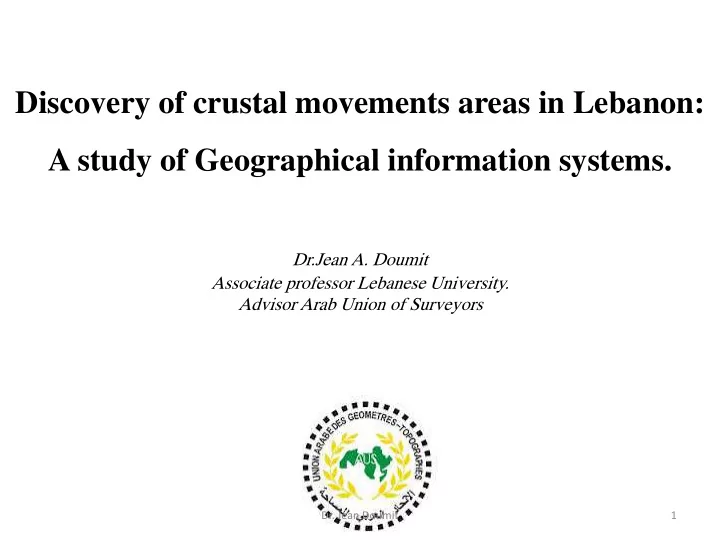

Discovery of crustal movements areas in Lebanon: A study of Geographical information systems. Dr.Jean A. Doumit Associate professor Lebanese University. Advisor Arab Union of Surveyors Dr. Jean Doumit 1
Table of contents • Introduction • Study area • Materials and Methods • Results • Conclusion
Introduction In 1975 Filosofov a Russian scientist describe a method of mapping crustal movements, he used Strahler’s stream order classification for building base maps from each stream order. Then he calculated the difference between these base maps to extract a relative relief map in which high values express a higher probability of crustal movements. Filosofov in his research used traditional methods of calculations based on paper maps; from here was the idea to run the same experiment with the application of the new applied technologies in geography. Dr. Jean Doumit 3
Study area A specific geological diversity beginning from the sea to the highest point of Lebanon Sannine mountain with 3088m above the sea level, from the North the Bai of Jounieh to Faraya mountains ending at Beirut river valley. Dr. Jean Doumit 4
Materials and Methods Data base: Shuttle Radar Topography Mission (SRTM) with a spatial resolution of 90 m, available free of charges at the Consortium for Spatial Information (CGIAR-CSI) Dr. Jean Doumit 5
Hydrological analysis Using hydrology tool from ArcMap ESRI software for the stream network extraction we followed these steps: Dr. Jean Doumit 6
Sink fill In each Digital Elevation Model there are artifact or sinks, to prepare the DEM to a hydrological operation , these sinks must be filled to provide continuity in the stream model. Dr. Jean Doumit 7
Flow direction A flow direction raster extracted from the filled sink DEM showing the aspect of the slopes to trace the direction of the flow. Dr. Jean Doumit 8
Flow accumulation Based to the direction of the flow a new raster generated showing the accumulation of the flow. Dr. Jean Doumit 9
Stream order A final raster generation step based on Strahler method, Streams without tributaries are assigned first order; a second -order stream is the segment downstream the confluence of any two first - order streams; a third-order segment is formed by the junction of any two second-order streams and so on (Strahler 1952). Dr. Jean Doumit 10
Conversion Raster mode Raster to Vector Vector mode First and second stream order in green color in raster mode map. We excluded from our calculations the first and the second order forming artifacts of straight lines. Dr. Jean Doumit 11
Streams with the same orders are related to similar geological age, stream orders dynamics and terrain variations can be studied using an Isobase map. Isobase lines represent erosional surfaces which have formed due to recent tectonic and erosional events. Studies suggest that Isobase maps are prepared by interpolating the elevation at the location of 3 rd and 4 th order streams. Dr. Jean Doumit 12
Isobase maps 3 rd Order Isobase 4 th Order Isobase An interpolation of the stream orders elevations including the 3 rd order was done to build the isobase map of the 3 rd order and the same operation repeated excluding the 3 rd order to build the second isobase map of the 4 th order Dr. Jean Doumit 13
Result • A hydrological network extracted from DEM. • Isobase maps of third and fourth orders are made. • To quantify the amplitude of vertical movements, as well as identifying local active structures. The differences between the isobase maps of the third and the fourth orders show the algebraic sum of the vertical movements of the crust and erosion over time Filosofov (1960). Dr. Jean Doumit 14
• A reference map of crustal movements the crustal movements amplitude of the study area can vary from zero to 515 meters.The light to dark gray areas with low values begins from calm to moderate crust movements, Dr. Jean Doumit 15 yellow to red are the extreme areas of high amplitude of crust movement.
Conclusion The morphometric indices from GIS and DEM applications appear to be effective to detect tectonic activities and to understand the differential relative uplift. The isobase level are capable of identifying younger, probably tectonic features. Isobase analysis allowed discrimination of areas where the dominant geomorphic process is related to differential erosion from areas affected by tectonics. Dr. Jean Doumit 16
Please Email me at : jeandoumit@gmail.com Dr. Jean Doumit 17
Recommend
More recommend